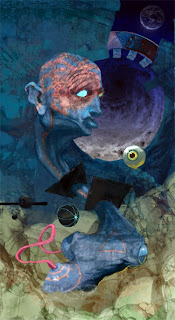 The last moments happened in slow motion as the car collided in a sickening crunch. His head smashed into the windshield, fracturing the frontal bones above his eyes and the orbital plates protecting his optic nerves. He was comatose for two weeks until he woke up. When he did, he could not walk or talk. For Larry MacDonald that was just the beginning. When he opened his eyes he could not "distinguish what was real from what was fake." He looked at the doctors and nurses standing by his bed. Behind and next them stood football players while Hawaiian girls danced the hula, hips swaying gently. His head was flooded with voices. He couldn't tell who was saying what, nor where the voices came from. He was thrown into panic and confusion.
The last moments happened in slow motion as the car collided in a sickening crunch. His head smashed into the windshield, fracturing the frontal bones above his eyes and the orbital plates protecting his optic nerves. He was comatose for two weeks until he woke up. When he did, he could not walk or talk. For Larry MacDonald that was just the beginning. When he opened his eyes he could not "distinguish what was real from what was fake." He looked at the doctors and nurses standing by his bed. Behind and next them stood football players while Hawaiian girls danced the hula, hips swaying gently. His head was flooded with voices. He couldn't tell who was saying what, nor where the voices came from. He was thrown into panic and confusion.Weeks passed, then months, and years. Gradually, as he gained control over his body functions, as he learned to walk, he also began to distinguish real voices from the imaginary. It was tough going, and he was not the same, but he kept at it. Five years later, he met V.S. Ramachandran.
He no longer saw football players and hula dancers as he once did, but he still had visual problems. Visual hallucinations occurred where he was blind, which was in the lower half of his field of vision. Everything in the upper half was normal; the lower half presented strange things indeed.
Ramachandran asked him what he was seeing. He saw dogs and elephants as they spoke. A monkey was sitting on Ramachandran's lap.
Ramachandran asked him how he knew he was not hallucinating. MacDonald explained that it was highly unlikely that a professor would have a monkey with him. Nonetheless, the monkey was "extremely vivid and real." Larry knew it was not real because after a while the image faded. Here is a review of the book in which this is described, Phantoms in The Brain: Probing The Mysteries of The Human Mind.
Larry MacDonald was a victim of Charles Bonnet syndrome. First described by Charles Bonnet in 1769, and named after him, Charles Bonnet Syndrome (CBS) is a disease that causes patients to have complex visual hallucinations.
Its victims are mentally healthy people who have vivid, complex recurrent visual hallucinations. An occasional characteristic is that things seem much smaller or larger in relation to oneself. If things seem smaller, the viewer feels like a giant, and vice versa.
CBS tends to affect people in old age, particularly some people with visual damage such as macular degeneration. More here and here.

No comments:
Post a Comment
Note: Only a member of this blog may post a comment.